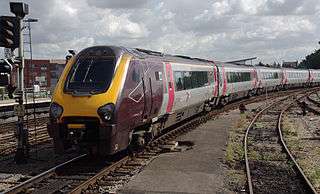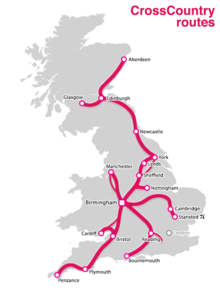Cross Country Route
The Cross Country Route is a long-distance rail route in the United Kingdom that has in its central part superseded the Midland Railway. It runs from Bristol to York via, Birmingham, Derby, Sheffield and Leeds. It facilitates some of the longest passenger journeys in the UK such as Aberdeen to Penzance.
| Cross Country Route | |
|---|---|
 | |
| Overview | |
| Type | Suburban rail, Heavy rail, Inter-city rail |
| System | National Rail |
| Status | Operational |
| Termini | York Bristol Temple Meads |
| Stations | 48 |
| Operation | |
| Owner | Network Rail |
| Operator(s) | CrossCountry (principal operator) East Midlands Railway Great Western Railway Northern TransPennine Express West Midlands Trains |
| Rolling stock | Class 43 HST (main stock) Class 170 Turbostar (main stock) Class 220 Voyager (main stock) Class 221 Super Voyager (main stock) |
| Technical | |
| Track gauge | 1,435 mm (4 ft 8 1⁄2 in) standard gauge |
| Electrification | Partial 25 kV AC OHLE |
| Operating speed | Up to 125 mph (200 km/h) maximum, some sections limited to 100 mph (160 km/h) |
The line is classed as a high-speed line because its sections from Birmingham to Wakefield and from Leeds to York have a speed limit of 125 mph (200 km/h), though the section from Birmingham to Bristol is limited to 100 mph (160 km/h) due to there being numerous level crossings, especially half-barrier level crossings, and the section from Wakefield to Leeds has the same limit owing to a number of curves.
History
The Birmingham to Bristol section was built as the Birmingham and Gloucester and Bristol and Gloucester Railways[n 1] before joining the Midland Railway, the southern forerunner to the cross-country route. From Birmingham to the north-northeast, the line had three separately owned sections, namely the:
- Birmingham and Derby Junction Railway to Derby, thence the
- North Midland Railway to Leeds, thence the
- York and North Midland Railway.
From the Labour Government's nationalisation in 1948 until privatisation in 1990 it ran through six regions of British Rail but had (timetabling) priority in none of them and therefore the services were poorly promoted and thus not always well-patronised.
Most Derby-Nottingham local passenger trains were taken over by diesel units from 14 April 1958, taking about 34 minutes between the two cities.[1]
In the 1990s most services were operated by British Rail's InterCity business unit. As part of the privatisation of British Rail, these were taken over by Virgin CrossCountry in 1997 with the Class 47 hauled Mark 2 and High Speed Train sets replaced by Class 220 and Class 221 diesel multiple units in the early 2000s.[2][3]
The use of the route for freight has decreased, due to the bulk of haulage switching to roads and the building of the M5, M6 and M1 motorways.
Abortive British Rail proposals for complete electrification
In the 1960s the route was considered for electrification. In the early 1980s, electrification was again discussed at length and documentation for various proposals was produced in 1981.[4] This would have been particularly beneficial for climbing the Lickey Incline between Cheltenham and Birmingham, as many of the early diesels were under-powered. In 1977 the Parliamentary Select Committee on Nationalised Industries recommended considering electrification of more of Britain's rail network, and by 1979 BR presented a range of options that included electrifying the cross-country route by 2000.[5] Under the governments that succeeded the 1976–79 Labour government the proposal was not implemented.
Route

The route is well connected, and aside from its own alignment it uses parts of the South Wales Main Line, Midland Main Line, Swinton–Doncaster line, and the East Coast Main Line. Major cities and towns served along the route include:
- Nominal start-point at Derby
Milepost zero for the main predecessor Derby to Bristol route has always been Derby, hence a train travelling the whole route starts out going "up" then becomes "down". The Birmingham to Derby section of the route has a line speed of 125 mph (200 km/h), while Birmingham to Bristol is restricted to 100 mph (160 km/h) due to a number of half-barrier level crossings.
Electrification
The line is not fully electrified, but some sections are overhead electrified at 25 kV AC such as Bromsgrove to Grand Junction, with further electrified sections around Leeds and the East Coast Main Line near York.[6] The section between Leeds and York is due to be fully electrified by 2022 with the electrification of the North TransPennine from Liverpool Lime Street to York via Manchester Piccadilly,[7] as is the section between Westerleigh Junction and Bristol Temple Meads as part of the 21st-century modernisation of the Great Western main line.
Network Rail stated in 2014 that the line between Derby and Sheffield would be electrified as part of the Midland Main Line upgrade.[8] However, the electrification programme was severely cut back in July 2017.[9]
Services
Most long distance services on the route are operated by Class 220/221 Voyagers, although a few services operate using High Speed Trains. These trains are capable of achieving 125 mph (200 km/h), compared to the previous Class 47s and Mk 2 coaching stock, which had a top speed of 95 mph (150 km/h).
See also
Notes and references
- Notes
- Briefly amalgamated as the Birmingham and Bristol Railway
- References
- Railway Magazine June 1958 p. 432
- Virgin says farewell to 47s with Penzance - Derby trip Rail issue 443 4 September 2002 page 16
- CrossCountry HSTs bow out The Railway Magazine issue 1230 October 2003 page 84
- "1981 Railway archive" (PDF). 1981.
- Railway Electrification. British Railways Board (Central Publicity Unit). Winter 1979. pp. 0–2, 8.
- "First electric train travels between Birmingham and Bromsgrove". Global Railway Review. Retrieved 7 June 2018.
- Philip Haigh (14 December 2011). Nigel Harris (ed.). "£290m to wire York-Manchester trans-Pennine route". Rail (685): 8–9.
- "Midland Mainline improvement programme – Network Rail". Network Rail. Archived from the original on 26 December 2016. Retrieved 4 May 2018.
- "Rail electrification plans scrapped". BBC News: Business. 20 July 2017. Archived from the original on 25 August 2017. Retrieved 31 October 2017.
External links
| Wikimedia Commons has media related to Cross Country Route. |